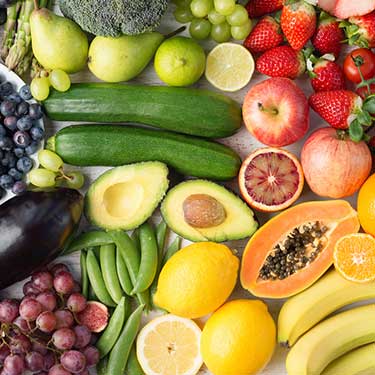
By
 Copy URL to Clipboard
Copy URL to Clipboard
The USA is the world’s number one importer of Mexican produce. Mexico’s climate is warm nearly year-round, making the country an ideal source of fruits and vegetables. Importers who wish to take advantage of the demand for Mexican produce need to familiarize themselves with shipping procedures and regulations from the Food and Drug Administration (FDA).
Key Takeaways
Join us as we dig into the details of shipping produce from Mexico to the U.S.
Table of Contents
The USA imports billions of dollars worth of produce from Mexico on a yearly basis. To highlight some of the best-performing fruits and vegetables by dollar value, I’ve compiled import data on popular Mexican produce in the tables below.
| Vegetables | Value of Imports in USD |
| Tomatoes | $2.71 billion |
| Garlic, Onions, Leeks, Shallots, and Other Vegetables Containing Allicin | $444 million |
| Cabbages, Cauliflower, Kohlrabi, Kale and Similar Edible Brassicas | $718 million |
| Lettuce and Chicory | $508 million |
| Carrots, Turnips, Celeriac, and Other Edible Roots | $130 million |
| Cucumbers and Gherkins | $805 million |
| Leguminous Vegetables Including Peas, Beans, Chickpeas, and Lentils | $181 million |
| Other Vegetables, Including Asparagus, Mushrooms, Peppers, and Spinach | $2.96 billion |
| Frozen Vegetables | $655 million |
| Fruit | Value of Imports in USD |
| Dates, Figs, Pineapples, Avocados, Guavas, Mangoes and Mangosteens | $3.3 billion |
| Citrus Fruit | $856 million |
| Grapes | $835 million |
| Melons and Papayas (Papaws), Fresh | $569 million |
| Other Fresh Fruit Including Strawberries, Raspberries, Blackberries, Currants, and More | $3.9 billion |
| Fruits and Nuts, Frozen | $328 million |
The two most important factors in ensuring that your produce arrives in acceptable condition are packing and shipping practices.
Related: A Guide to Shipping Tomatoes From Mexico
Although it depends on the specific fruit or vegetable, produce is usually packed in clamshell packaging, plastic wrap, or plastic bags. These smaller containers are then packed inside a ventilated shipping box, which allows air to circulate evenly throughout the shipment. These large boxes are palletized together for ease of transport via truck or rail.
Speaking of transport, temperature and humidity control inside the shipping container is crucial to prolonging shelf life and preventing spoilage.
Humidity and temperature requirements vary from one piece of produce to another. In the following tables, I’ve listed those requirements for some of the most popular fruits and vegetables imported from Mexico.
| Type of Produce | Recommended Shipping Temperature | Optimum Humidity |
| Tomatoes | 55-60°F, 12.7-15.5°C | 85-90% |
| Avocados | 45-50°F, 7.2-10°C | 95% |
| Oranges | 34-44°F, 2-7°C | 90% |
| Cabbage | 32°F, 0°C | >95% |
| Lettuce | 32°F, 0°C | 95-100% |
| Cucumbers | 50-53.6°F, 10-12°C | 95% |
| Cantaloupes | 37.4-39.2°F, 3-4°C | 90-95% |
| Garlic | 30.2-32°F, -1-0°C | <75% |
| Onions | 32°F, 0°C | 65-75% Dry >95% green |
| Grapes | 30.2-32°F, -1-0°C | 90-95% |
Shipping produce outside its optimum temperature range can render it inedible, so make sure you clearly communicate the temperature requirements of your shipment to your carrier. Failure to do so could result in your shipment arriving in unacceptable condition.
Assuming your shipment is properly packed and shipped, your next obstacle will come up when it’s time to cross the border into the USA.
Related: Shipping Avocados From Mexico to the United States
Like many perishable foods, produce is highly regulated by the FDA and the U.S. Department of Agriculture (USDA). Due to the risk of bringing over foreign pests and diseases, the regulatory process is rigorous.
In order to ship vegetables into the USA from Mexico, you’ll need to follow several regulations, including:
Depending on the time of year, duty rates may fluctuate in order to level the playing field with produce farms in the United States. Under the USMCA, most goods traded between the participating countries are duty free in the first place, but it’s always a good idea to make sure you won’t encounter unexpected fees at the border.
Further regulations are based on factors like the size and quality of the produce. For instance, most imported grapes must be at least 10/16 of an inch (1.5875 CM) in size, and aren’t considered mature unless the juice meets or exceeds 16.5% soluble solids as part of its mass.
U.S. Customs and Border Protection (CBP) is in charge of regulating the flow of goods into the U.S., and requires several specific documents to accompany any foreign shipment entering the country.
These documents include a:
Often times, businesses will partner with a customs broker to fill out and submit the necessary paperwork for importing shipments of produce. This reduces the chances of errors that could hold up a shipment at the border.
If you’re interested in shipping fruits and vegetables from Mexico, you’ll want to work with a carrier who understands the ins and outs of maintaining correct shipping conditions and clearing U.S. customs. That’s where we come in.
At R+L Global Logistics, our multilingual staff has over 30 years assisting shippers with the complex nature of shipping produce across international borders. By only working with the most trusted carriers, we can boast a 99.5% on-time delivery record, even on expedited shipments! We can also ensure that your produce is shipped under the correct temperature and humidity conditions.
Our full list of logistics and customs services includes:
If you’re looking for assistance of any kind with importing produce from Mexico, give us a call at (866) 335-0495 or contact us online. We’ll help you sow the seeds of a profitable import business.
 Copy URL to Clipboard
Copy URL to Clipboard
